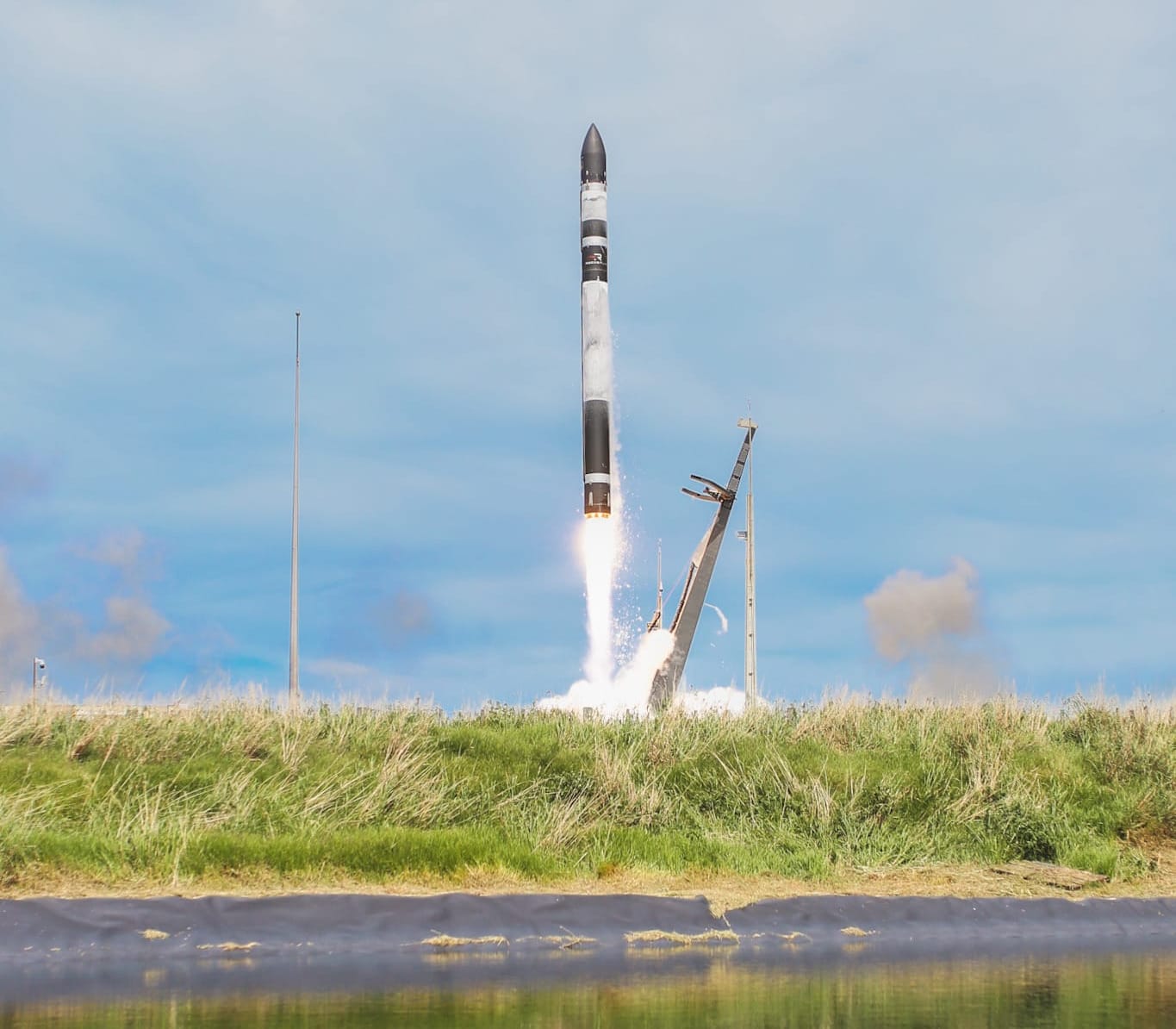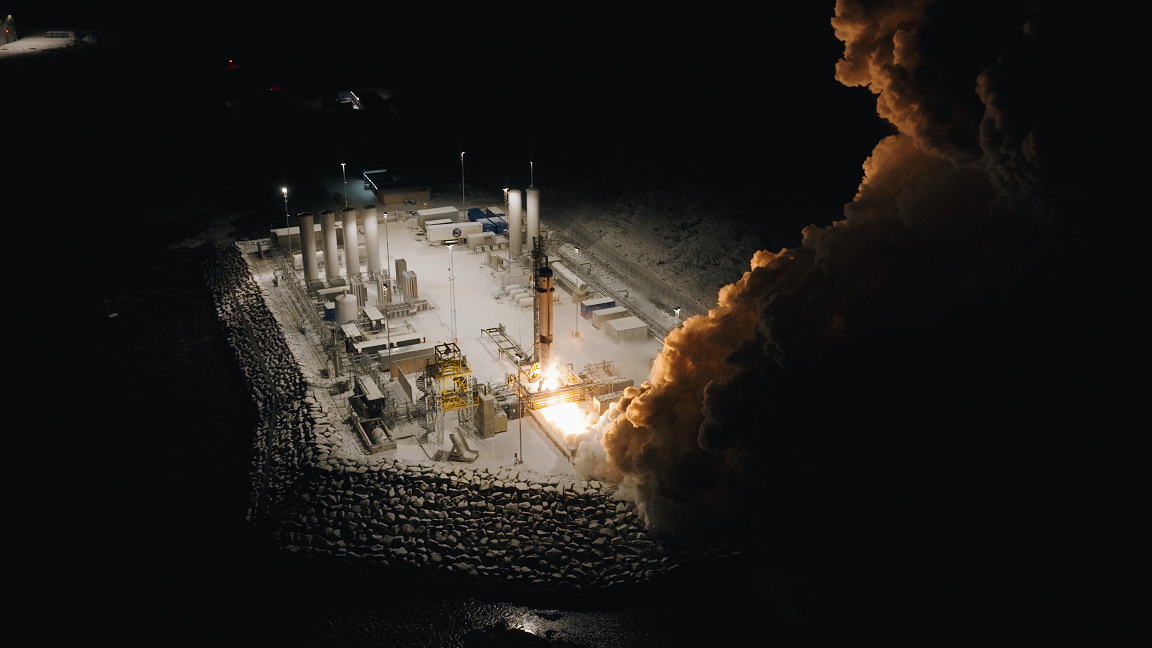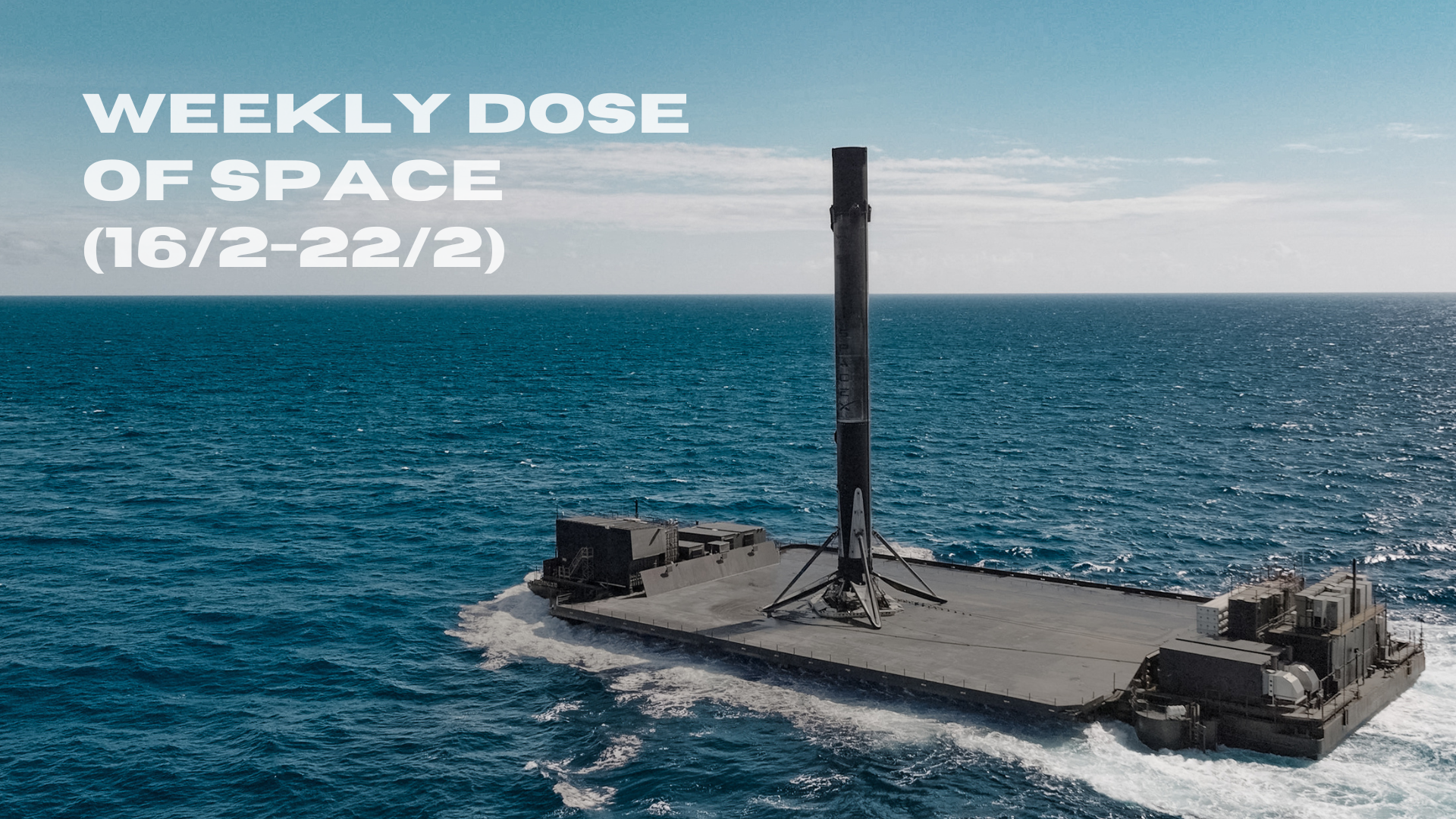Table of Contents
Welcome back to Weekly Dose of Space! This week had five launches taking place, with most carrying Starlink satellites. News this week had the Artemis II SLS boosters completing stacking, a new European rocket preparing to launch, PLD Space planning launches from Oman, and some key figures leaving NASA. As always, we'll also look ahead to what the worldwide launch schedule might look like next week.
Launches This Week
February 18th - Electron for 'Fasten Your Space Belts'
Rocket Lab launched its Electron rocket from Launch Complex 1B, on the Māhia Peninsula in New Zealand, carrying a commercial imaging satellite into low Earth orbit from BlackSky.

February 18th - Falcon 9 with Starlink Group 10-12
A Falcon 9 lifted off from Space Launch Complex 40, in Florida, carrying twenty-three Starlink satellites into low Earth orbit. Supporting the launch was booster B1080 on its sixteenth flight, with a landing on the drone ship 'Just Read The Instructions' downrange.
Falcon 9 aboard the Just Read the Instructions droneship after successfully completing our first international landing off the coast of The Bahamas pic.twitter.com/o59NcQhRXP
— SpaceX (@SpaceX) February 19, 2025
Booster B1080 aboard 'Just Read The Instructions' heading back to Florida, via SpaceX on Twitter.
February 21st - Falcon 9 with Starlink Group 12-14
Another Falcon 9 lifted off from Space Launch Complex 40 carrying another twenty-three Starlink satellites to low Earth Orbit. This launch was supported by B1076 on its twenty-first flight, and landing downrange on the drone ship 'A Shortfall Of Gravitas'.

February 22nd - Long March 3B/E with ChinaSat-10R
A Long March 3B/E lifted off from Launch Complex 2 at the Xichang Satellite Launch Center carrying the ChinaSat-10R spacecraft to a geostationary transfer orbit. The ChinaSat-10R spacecraft is a replacement for the aging ChinaSat-10 and will provide communications and data services for China and other Belt and Road initiative nations.

February 22nd - Falcon 9 with Starlink Group 15-1
Twenty-two more Starlink satellites were carried into low Earth orbit by a Falcon 9 flying from Space Launch Complex 4E, in California. Booster B1082 supported this launch, for its eleventh flight with a landing on the drone ship 'Of Couse I Still Love You' downrange.
In Other Space News
Artemis II booster stacking completed

NASA announced on February 19th that it had completed the stacking of its Space Launch System's (SLS) two solid rocket boosters ahead of the Artemis II mission next year. Both of the boosters consist of five segments, an avionics package, and a nosecone, with a total height of 54 meters (177 feet).
Stacking of the two boosters began back in November 2024, with teams gradually stacking all of the hardware over the last four months. Throughout the remainder of the year, teams will lift SLS' core stage between the boosters, followed by attaching the Launch Vehicle Stage Adapter atop of the core before the Interim Cryogenic Propulsion Station is stacked too. Eventually, the Orion spacecraft, including its service module and launch abort system, will be stacked to complete the vehicle.
NASA's Artemis II mission, which will utilize the SLS currently being stacked, is currently set to launch around April 2026. This mission will carry NASA astronauts Reid Wiseman, Victor Glover, and Christina Koch, as well as Canadian Space Agency astronaut Jeremy Hansen, on a 10-day journey around the Moon.
Isar Aerospace conducts static fires

On February 21st, European launch company Isar Aerospace announced that it had completed static fires for both stages of its Spectrum launch vehicle. These static fires were completed in Norway, ahead of a maiden flight from the Andøya Spaceport.
Isar Aerospace states that all nine first-stage engines were lit for a static fire on February 14th, while the second-stage performed a static fire back in quarter three 2024. Commenting on the successful tests and the upcoming first flight, Daniel Metzler, Isar's Chief Executive Officer and Co-Founder, said:
“We are almost ready for the test flight. All we need is the license” – “By enabling space access from mainland Europe, we provide a critical resource for ensuring sovereignty and resilience." – “I am extremely proud of our international team from over 50 nations. Reaching this milestone is a huge success in itself. And while Spectrum is ready for its first test flight, launch vehicles for flights two and three are already in production.”
No target dates have been shared for Spectrum's maiden flight but Isar is currently awaiting regulatory approval and a launch license from the Norwegian Civil Aviation Authority.
PLD Space to launch Miura-5 from Oman
Spanish Launch Company PLD Space announced on February 20th that it had signed an agreement with Oman's Etlaq Spaceport to launch its Miura-5 rockets. Etlaq will be the company's second launch site, which is already working on a launch pad at the Guiana Space Centre in French Guiana.
PLD Space states that the choice to set up a launch site in Etlaq was due to dry and predictable weather, large swaths of oceans downrange, and the ability to launch into either a polar, sun-synchronous, or 50-degree low Earth orbit. Speaking on the need for the site, Co-Founder of PLD Space Raúl Verdú stated:
"Given the current shortage of launch infrastructure, we are excited to announce this strategic collaboration with Etlaq, which presents itself as a strategic solution to meet the needs of our customers globally," – "We will begin working with Etlaq on the design, engineering, and construction of our launch base with the goal of performing the first MIURA 5 flight from there in 2027."
PLD Space expects Miura-5 to fly from Etlaq in 2027 followed by other rockets of its Miura launch vehicle series, including the larger reusable Miura Next vehicles. The company is also looking into flying its LINCE crew capsule from the site.
Founder and Chief Executive Officer of the Etlaq Spaceport, His Highness Sayyid Azzan bin Qais Al Said, commented on the agreement with PLD Space adding:
“We are proud to reach this milestone with PLD Space. This collaboration with PLD Space demonstrates the increasing role of Oman in the global space sector. By working with international launch providers, we aim to enhance our capabilities and contribute to the growing demand for flexible, efficient, and well-positioned spaceports. We look forward to continuing to build partnerships that strengthen Etlaq’s role as a key player in the industry.”
Jim Free and other key Artemis officials leave NASA
Effective from February 22nd, announced on February 19th, NASA's associate administrator Jim Free has retired from NASA. The day before three unnamed key officials also reportedly retired from NASA's Marshall Space Flight Center, located in Huntsville Alabama, who were key parts of the agency's Artemis program in its current setup. Reminiscing on his time at NASA, Jim Free said:
“It has been an honor to serve NASA and walk alongside the workforce that tackles the most difficult engineering challenges, pursues new scientific knowledge in our universe and beyond, develops technologies for future exploration endeavors, all while prioritizing safety every day for people on the ground, in the air, and in space,” – “I am grateful for the opportunity to be part of the NASA family and contribute to the agency’s mission for the benefit of humanity.”
Free's retirement has come during a transition period for the agency as it navigates the shifting plans of the second Trump administration. Free had been set to become acting NASA administrator for the transition but was passed up for Janet Petro, head of the Kennedy Space Center, instead. Neither NASA nor the White House have provided a reason why Free was not selected but it is said to have been on grounds of political beliefs.
During the transition period, NASA is also dealing with the 'Department of Government Efficiency' and its attempts to slash the space agency's workforce. The so-called efficiency department is headed by Elon Musk and aims to remove trillions of dollars from government spending with no oversight or transparency. A few days ago Musk's efficiency department tried, and thankfully failed, to reduce NASA's workforce by a level not seen since the end of the Apollo program in the 1970s.
What to Expect Next Week
February 24th - Falcon 9 with Starlink Group 12-13
SpaceX is expecting to launch a Falcon 9 from Space Launch Complex 40 carrying a batch of Starlink satellites to low Earth orbit.
February 25th - Ceres-1 with a to-be-announced payload
Galactic Energy may launch its Ceres-1 rocket from the Jiuquan Satellite Launch Center carrying several unannounced satellites into a sun-synchronous orbit.
February 25th - New Shepard for NS-30
Blue Origin is planning to launch its tenth suborbital crewed mission carrying Lane Bess, Jesús Calleja, Elaine Chia Hyde, Dr. Richard Scott, Tushar Shah, and one more unannounced crew member above the Kármán line.
February 26th - Starship-Super Heavy for its eighth flight test
SpaceX could be attempting Starship-Super Heavy's eighth flight test on February 26th utilizing Ship 34 and Booster 15.
February 27th - Falcon 9 with Nova-C IM-2 and other payloads
A Falcon 9 is planned to launch from Launch Complex 39A carrying Intuitive Machines second Nova-C lander for the IM-2 mission, NASA's Lunar Trailblazer satellite, and an unknown commercial satellite to a lunar transfer orbit.
February 27th - Long March 2C with a to-be-announced payload
A Long March 2C may launch from the Jiuquan Satellite Launch Center carrying a currently unannounced payload.
February 27th - Soyuz 2.1a with Progress MS-30
A Progress resupply spacecraft is expected to launch to the International Space Station atop of a Soyuz 2.1a flying from the Baikonur Cosmodrome.
February 28th - Falcon 9 with Starlink Group 12-20
Another batch of Starlink satellites are expected to head to low Earth orbit atop of a Falcon 9 flying from Space Launch Complex 40.
March 1st - Falcon 9 with SPHEREx and PUNCH
A Falcon 9 is planned to launch from Space Launch Complex 4E into a polar orbit carrying NASA's SPHEREx (Spectro-Photometer for the History of the Universe, Epoch of Reionization, and Ices Explorer) and PUNCH (Polarimeter to Unify the Corona and Heliosphere) spacecraft.
We have dropped the two SpaceX Starbase segments from our newsletter due to an increasing lack of publicly visible activity at the site. We will still report major goings-on in the 'In Other Space News' segment.







